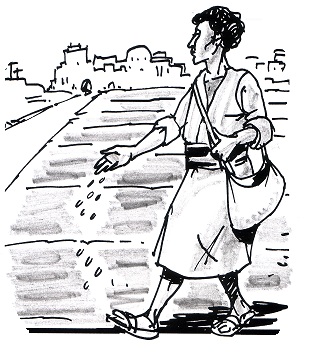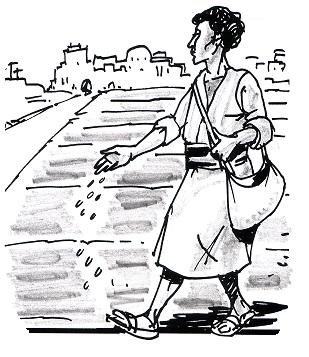

“A sower went out to sow” Mark 4:2).
2 Tm 1:1-8 or Ti 1:1-5; Mark 4:1-20
Memorial of Saints Timothy and Titus, bishops
Celebrating Timothy and Titus the day after celebrating the conversion of St. Paul reminds us that Paul’s ministries always involved teams of helpers, including women heads of house churches, married couples and others who helped maintain the churches Paul had founded. Timothy and Titus are mentioned in Paul’s letters as important companions. While the personal letters addressed to them are later additions to the Pauline corpus, linking them to the parable in Mark’s Gospel reminds us that Paul and his fellow missionaries sowed the seeds of faith that established the first generation of the church.
A plausible chronology of Paul’s life suggests that his conversion took place shortly after the death of Jesus, around 34 CE, and for the next 30 years of his life, Paul absorbed, articulated and shared his encounter with Jesus, the crucified and risen Christ. It was though he saw so much all at once on the road to Damascus that it blinded him. He was so overwhelmed, Paul first retreated into Arabia for several years, then went to Jerusalem to meet with the leaders of the church but was rebuffed and withdrew to Tarsus for almost a decade.
According to Acts, Barnabas retrieved Paul around 43 CE and convinced him to come to Antioch, and the first of three missionary journeys was launched from there. As the Jesus movement spread among the Gentiles, a key meeting was convened in Jerusalem around 49 CE, and Paul’s mission to the Gentiles was accepted. Timothy and Titus were with Paul during the second and third missionary trips during which Paul’s letters were written.
What we can draw from this is that despite the way the story is telescoped in the Acts of Apostles to give the impression that everything happened in quick succession to launch the church from Jerusalem to Rome, in fact there was a long and gradual development of the Jesus movement even before the four Gospels were written. Paul’s letters in large part became the theological foundation of the New Testament, articulating who Jesus was and what his life, death and resurrection meant.
As the parable of the sower suggests, the spread of the church flourished in the midst of adversity. Some seed fell on the path, on shallow soil, among thorns, yet it has always found good ground and taken root.
The first generation of disciples came to grasp the astonishing revelation of what God had done in Jesus in much the same gradual way we come to faith today. We grow into the mystery by living it, by finding Jesus in our own human experience and in the events of our time. The crucified Christ gives meaning to our suffering and losses, and the risen Christ renews our confidence and joy as we realize the hope he offers us.
Future generations will look back on us and praise us for our fidelity in difficult times, for embracing the faith and handing it on to the next generation.
Advertisement







